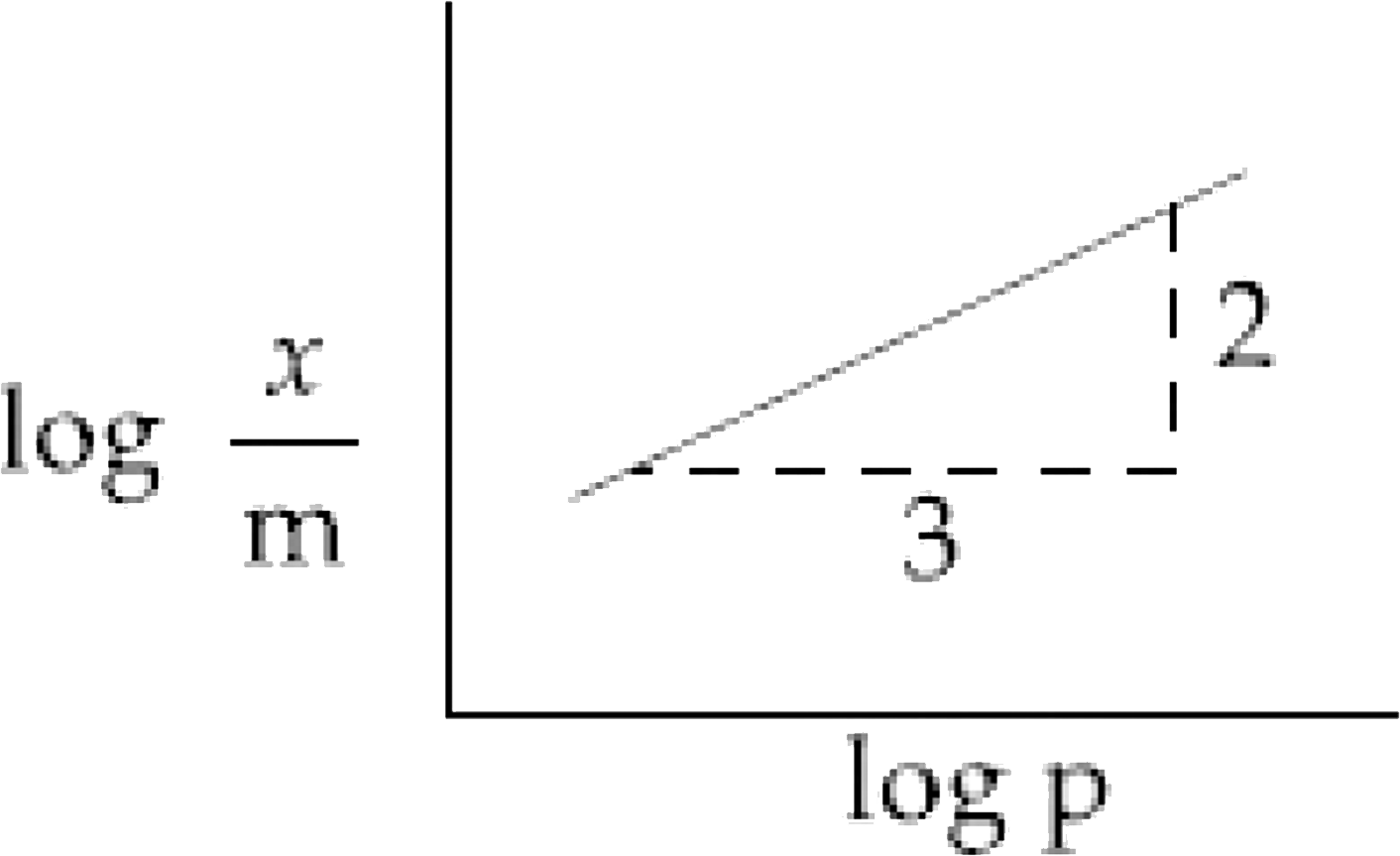If x gram of gas is adsobed by m gram of adsorbent at pressure P the plot of log xm versus log P is linear .the slope of the plot is :
(n and k are constant and n > 1)
logK
n
2k
1/n
To find the slope of the plot of log(x/m) versus log(P), we can follow these steps:
1. Understanding the Adsorption Isotherm:
We start with the Freundlich adsorption isotherm, which states that the amount of gas adsorbed (x) is proportional to the pressure (P) raised to the power of 1n:
xm∝P1n
2. Expressing the Proportionality:
To convert the proportionality into an equation, we introduce a constant k:
xm=kP1n
3. Taking Logarithms:
We take the logarithm of both sides of the equation:
log(xm)=log(k)+log(P1n)
Using the property of logarithms that states log(ab)=blog(a), we can rewrite the equation:
log(xm)=log(k)+1nlog(P)
4. Rearranging the Equation:
We can rearrange this equation to match the form of a straight line y=mx+c:
log(xm)=1nlog(P)+log(k)
Here, y=log(xm), x=log(P), slope m=1n, and intercept c=log(k).
5. Identifying the Slope:
From the equation, we can see that the slope of the plot of log(x/m) versus log(P) is:
slope=1n
Conclusion:
Thus, the slope of the plot of log(x/m) versus log(P) is 1n.
We start with the Freundlich adsorption isotherm, which states that the amount of gas adsorbed (x) is proportional to the pressure (P) raised to the power of 1n:
xm∝P1n
To convert the proportionality into an equation, we introduce a constant k:
xm=kP1n
We take the logarithm of both sides of the equation:
log(xm)=log(k)+log(P1n)
Using the property of logarithms that states log(ab)=blog(a), we can rewrite the equation:
log(xm)=log(k)+1nlog(P)
We can rearrange this equation to match the form of a straight line y=mx+c:
log(xm)=1nlog(P)+log(k)
Here, y=log(xm), x=log(P), slope m=1n, and intercept c=log(k).
From the equation, we can see that the slope of the plot of log(x/m) versus log(P) is:
slope=1n
Thus, the slope of the plot of log(x/m) versus log(P) is 1n.
Topper's Solved these Questions
- SURFACE CHEMISTRYBOOK - VMC MODULES ENGLISHCHAPTER - SURFACE CHEMISTRYEXERCISE - JEE Advanced (Archive)
10 Videos
- SURFACE CHEMISTRYBOOK - VMC MODULES ENGLISHCHAPTER - SURFACE CHEMISTRYEXERCISE - ILLUSTRATIONS
14 Videos
- SURFACE CHEMISTRYBOOK - VMC MODULES ENGLISHCHAPTER - SURFACE CHEMISTRYEXERCISE - JEE Main (Archive)
14 Videos
- STRUCTURE OF ATOMBOOK - VMC MODULES ENGLISHCHAPTER - STRUCTURE OF ATOMEXERCISE - IN-CHAPTER EXERCISE-F
7 Videos
- THE SOLID STATEBOOK - VMC MODULES ENGLISHCHAPTER - THE SOLID STATEEXERCISE - EXERCISE-J
10 Videos
Similar Questions
Knowledge Check
In a plot of log k vs 1/T, the slope is
A−Ea/2.303BEa/2.303RCEa/2.303D−Ea/2.303RIn a plot of log k vs 1/T, the slope is
A−Ea/2.303BEa/2.303RCEa/2.303D−Ea/2.303RIn a plot of log k vs 1/T, the slope is
A−Ea/2.303BEa/2.303RCEa/2.303D−Ea/2.303R
The intercept on Y - axis in the graph of log xm versus log P gives
View SolutionAdsorptionof a gas follows Freundlich adsorption isotherm. x is the mass of the gas adsorbed on mass m of the adsorbent.
The plot of logxm versus log p is shown in the given graph xm is proportional to :

View SolutionAdsorption of gas follows Freundlich adsorption isotherm. x is the mass of the gas adsorbed on mass m of the adsorbent. The plot of logxm versus log p is shown in the given graph.
xm is proportional to:

View SolutionFor a linear plot of log (x/m) versus log [ in a Freundlich adsorption isotherm, which of the following statements is correct ? (k and n are consists)
View SolutionFor the Arrhenius equation, the slope for the plot ln k vs 1/T is
View Solution
